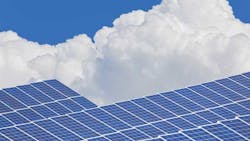Solar Manufacturing Industry Braces with Looming Glut Eroding Prices
Solar manufacturers that are ramping up production now face a looming glut of panels, forcing companies to adjust or face dire consequences.
Trina Solar Ltd., Canadian Solar Inc. and JinkoSolar Holding Co. are among the suppliers boosting output at factories that will expand global capacity by 18% this year, according to Bloomberg New Energy Finance.
The manufacturers are locked in a race to build bigger and more advanced factories to crank out panels faster and cheaper. Just as they start rolling off the lines, demand is expected to slow, especially in China where the government rolled back subsidies last month. Prices are slumping, and suppliers expect margins to slip as well. It’s a pattern we’ve seen before, after a global oversupply five years ago drove dozens of companies out of business.
“Oversupply appears to be business as usual in the solar industry,” said Jenny Chase, New Energy Finance’s lead solar analyst.
The solar industry went through a similar boom-bust cycle after capacity grew faster than demand, triggering a two-year slump starting in late 2011. The result was a wave of consolidation as prices plunged and panelmakers’ losses piled up. Cheap panels also helped spur demand for more solar power, eventually prompting the survivors to expand production.
Fighting for Market Share with More Capacity
“These companies are all fighting for market share, and their tendency is to build more and more capacity,” Pavel Molchanov, an analyst at Raymond James Financial Inc., said in an interview. “Ultimately that drives down prices and margins for everyone.”
Trina, the world’s largest panel maker, said Tuesday that shipments will fall as much as 6.5% in the third quarter, to between 1.55 and 1.65 gigawatts. At the same time, the company has increased production capacity 7.1% after opening a 500-megawatt factory in Thailand in March. Yingli Green Energy Holding Co. said Tuesday that it expects shipments to slip as much as 54% in the current quarter, after 60% of its panels went to China in the second quarter.
Chinese Solar Demand Slows
“Chinese solar manufacturers now face tougher competition due to a supply capacity increase and a decrease in market demand,” Yingli Green Energy Vice President and Chief Climate Officer Jingfeng Xiong said during a call Tuesday with analysts.
To be clear, demand for solar is continuing to rise, but that growth is slowing. Global installations this year may reach about 67 gigawatts, up 27% from last year, according to New Energy Finance. In 2017, it’s expected to increase by 25%, and in 2018 it will rise 23%.
It’s hard to pinpoint whether supply has already eclipsed demand since companies won’t report whether their shipments have been impacted by the reduced subsidy in China until the fourth quarter. Evidence is mounting, however, that the glut has already arrived. Panel prices are at a record low of 44.7 cents a watt after plunging 10% in the past six weeks. Prices may fall another 15% by the end of the year, according to Patrick Jobin, an analyst at Credit Suisse Group AG.
While the last supply glut ravaged the solar industry, it may have less impact this time because the supply chain is more consolidated. The market has fundamentally changed, with 90% of sales going to a handful of the biggest companies, compared with 66% four years ago, said Xiaoting Wang, a New Energy Finance analyst. Industry leaders like Trina and Canadian Solar have expanded beyond manufacturing, diversifying their revenue by developing solar farms.
While manufacturers may have known they were speeding toward a glut, it’s not easy to take their foot off the gas. Many production costs are fixed, so cutting output would drive down margins and erode their market share.
Collective 'Suicide'
“They would essentially be giving up the race,” said Chase of New Energy Finance. “And nobody wants to do that –- even though collectively it’s suicide.”
Canadian Solar is one of the few companies that has announced it is scaling back its manufacturing expansion, adding 5.8 gigawatts of capacity this year instead of an initial target of 6.4 gigawatts.
“Canadian Solar’s objective this year is to play safe, not to grow our market share, but to improve our margin structure,” Canadian Solar Chief Executive Officer Shawn Qu said during an Aug. 18 conference call with analysts.
It’s unclear how long a supply glut may last. Wang, of New Energy Finance, said it may take two years to work through surplus capacity.
The key is how the companies react, whether they take a cautious approach or continue the race to build more factories, according to Merry Xu, chief financial officer at Trina.
“It just depends on the strategic approaches of our peers,” Xu said on a call with analysts Tuesday. “We do hope that this imbalance won’t last very long.”
By Joe Ryan
About the Author
Bloomberg
Licensed content from Bloomberg, copyright 2016.
